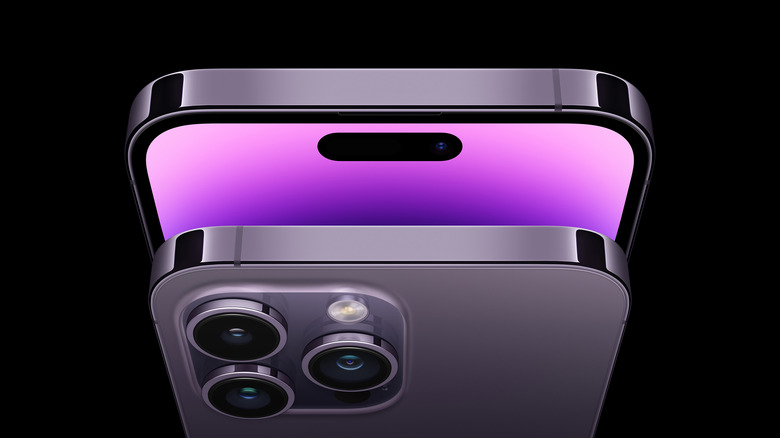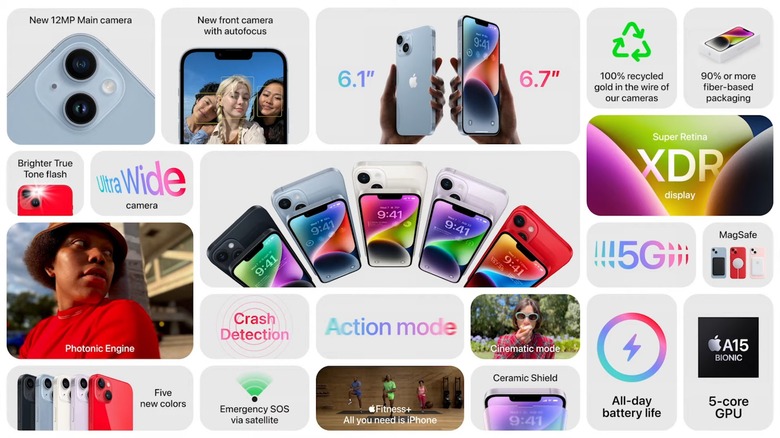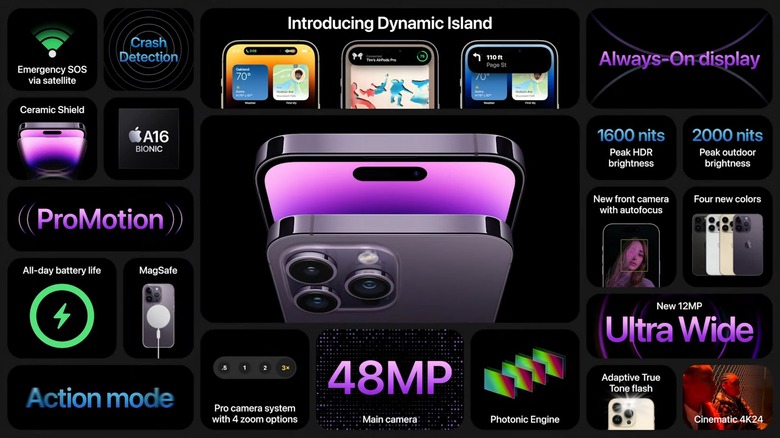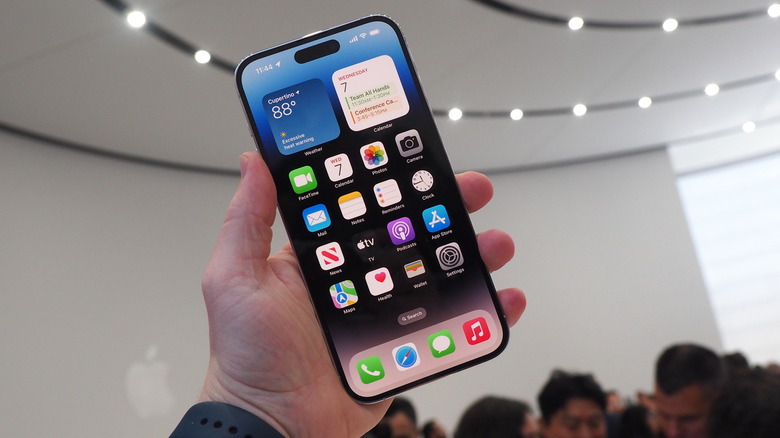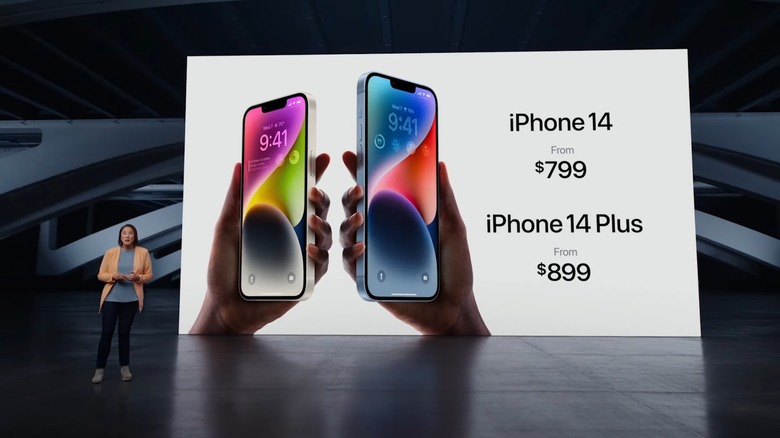iPhone 14 Price And Differences: Which Model Is Best For You?
The iPhone 14 series has finally broken cover, and there are a few changes this time around that are going to excite and disappoint shoppers. The biggest portfolio change is that the mini is no more after a short two-year stint as the beloved compact iPhone model. Instead, Apple has brought back the Plus that we last saw with the iPhone 8 series all the way back in 2017. The Pro models, on the other hand, have finally ditched the ugly boat-shaped notch in favor of a huge pill-shaped cutout at the top with some neat tricks in tow.
There's no physical SIM slot on iPhone 14 models for buyers in the U.S., but satellite connectivity has arrived as a critical emergency support measure. Overall, there's a lot to unpack for buyers confused between the four iPhone 14 trims and trying to decide which one to pick. Do you plan to upgrade to the latest iPhone generation? If so, there are some core differences between each iPhone 14 series model, how much they cost, and what they bring to the table that you should know.
The four horsemen of size uniformity
Apple's latest and greatest smartphones come in four models: the iPhone 14, 14 Plus, 14 Pro, and the iPhone 14 Pro Max. The iPhone 14 and 14 Pro are the smaller siblings packing a 6.1-inch display each, while the Pro and Plus versions offer a 6.7-inch screen. The resolution varies, of course, and the 120Hz refresh rate perk is only limited to the iPhone 14 Pro duo.
The iPhone 14 (2532 x 1170 pixels, 460ppi) and iPhone 14 Plus (2778 x 1284 pixels, 458ppi) can only reach a peak brightness output of 1,600 nits, while the iPhone 14 Pro (2556 x 1179 pixels, 460ppi) and the iPhone Pro Max (2796 x 1290 pixels, 460ppi) can go all the way up to 2,000 nits. Aside from a different approach to the notch design, there are a few other differences when it comes to the build and design.
The non-Pro iPhone 14 relies on an aluminum frame with a glossy glass back and comes in Midnight, Purple, Starlight, Blue, and PRODUCT (RED) colors. As for the iPhone 14 Pro, the side rails are made from stainless steel while the rear glass panel has a frosted finish. Color options for this one include Space Black, Silver, Gold, and Deep Purple. All four trims offer an IP68-certified build, and the storage options (128GB, 256GB, and 512GB) are also uniform. However, the Pro models go all the way up to 1TB of onboard space.
A controversial non-upgrade
This year marks the first time that a new generation of iPhones is divided across two processor lines. The iPhone 14 and its Plus sibling are using the same A15 Bionic processor as the iPhone 13 series from last year. The new and improved A16 Bionic is reserved for the iPhone 14 Pro models. Both the processors offer six CPU cores and five GPU cores, but there's a core difference here. The A15 is based on TSMC's 5nm process, while the A16 Bionic has its foundations in the newer 4nm fabrication process that makes the chip faster as well as more energy efficient.
Another difference is in the battery life figures. Apple says that the iPhone 14 can last up to 20 hours of offline video playback, while the iPhone 14 Pro (despite an almost identical footprint) can go a bit longer for 23 hours. Similar is the case with the 6.7-inch models, with the iPhone 14 Plus rated for 26 hours of continuous local video playback, while the iPhone 14 Pro Max is touted to last for 29 hours. The charging tech, thankfully, remains the same.
All four iPhone 14 models offer a peak 20W wired charging support, which is honestly laughable in the face of Android flagships that have crossed the 100W fast-charging milestone. Apple claims that 30 minutes of plug-in time will fill the battery up to the halfway mark on each iPhone 14 trim. MagSafe support is here, too, promising a peak wattage of 15W for juicing up the battery.
Serious camera upgrades sans a price hike
Aside from a fresh notch design, the biggest difference between the Pro and vanilla iPhone 14 models is the upgraded camera hardware. The iPhone 14 and its Plus version stick with a dual-lens system that includes a 12-megapixel main camera and a 12-megapixel snapper for ultra-wide photography. On the Pro models with a triple-lens array on the back, the charge is now led by a 48-megapixel primary sensor, up from iPhone 13 Pro's 12-megapixel sensor.
The 12-megapixel ultra-wide camera on the iPhone 14 Pro also offers a wider aperture (f/2.2 vs f/2.4), which means it can take in more light data to deliver brighter and more detailed images and videos. For folks interested in long-range zoom photography, the iPhone 14 Pro is the only choice, thanks to its 12-megapixel telephoto camera that can muster a 3x optical zoom output.
There are also a few differences on the feature side of things, as only the Pro models can capture night mode portrait shots because of the LiDAR sensor at the back. Also, ProRAW photo capture and ProRes video recording are restricted to the Pro models. Moreover, the second-generation sensor-shift image stabilization tech is limited to the Pro models. Needless to say, if you want serious camera chops on your phone, the iPhone 14 Pro duo is where you should put your money, more so in 2022 than ever.
What you'll pay for the best iPhone 14 features
The connectivity suite is identical across the entire series, and so are the audio and video playback capabilities like Dolby Atmos Spatial Audio, Apple Lossless, and HDR with Dolby Vision. Interestingly, the iPhone 14 Pro models are listed on Apple's website with support for "precision dual-frequency GPS," while the non-Pro models only mention "GPS" support for location tracking. As a pleasant surprise, Apple hasn't hiked the price of its new phones this year. The iPhone 14 starts at $799 and the Plus model will have you forking $899. The iPhone 14 Pro has a base retail tag of $999, while the iPhone 14 Pro Max will erase $1,099 from your bank account.
So, here's the final outlook. If you seek an upgraded camera with fancy features, a fresh design with an unconventionally functional pill-shaped cutout at the top, a few extra hours of battery life, and a 120Hz screen refresh rate, the iPhone 14 Pro should be your next purchase. If you are planning to upgrade from the iPhone 13, you should probably skip those plans as the iPhone 14 is not much of an iterative blessing. The iPhone 14 is not a bad phone on its own, but it doesn't offer much of a meaningful upgrade value over its predecessor. For the rest – and Android converts, too – $799 is still a palatable price for what the iPhone 14 offers in return.
